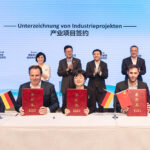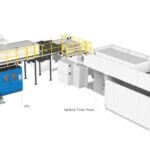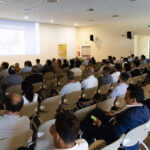FACTS, FIGURES, PRODUCTS In collaboration with Acimga, and in occasion of Converflex-Grafitalia 2013, Converting reviews the Italian sector of graphic arts, packaging and converting machinery and components producers. In the pages that follow, the sector analysis made by Felice Rossini, President of the association, and a review of Made in Italy state-of-the-art technologies.
 The structure and trends of the Italian sector of machinery for the paper/graphics/converting industry, the association’s commitment in the sphere of economic policy, its support for exports and the development of a business culture that can face the today’s challenges… Felice Rossini, incumbent president of Acimga, answers our questions about a market in transformation and which, for this very reason, requires something more in terms of analysis and entrepreneurial imagination.
The structure and trends of the Italian sector of machinery for the paper/graphics/converting industry, the association’s commitment in the sphere of economic policy, its support for exports and the development of a business culture that can face the today’s challenges… Felice Rossini, incumbent president of Acimga, answers our questions about a market in transformation and which, for this very reason, requires something more in terms of analysis and entrepreneurial imagination.
Can you give us an overview of the Italian printing and converting machine market? What are the emerging trends and what forecasts can we allow ourselves to make?
As confirmed by the latest figures, the sector industry is in trouble, especially in the segments not only affected by the global crisis and the restructuring of international market equilibrium, but also by the changes generated by the new communication technologies. For example offset and web offset press manufacturers are suffering greatly and to our partial consolation we can only point out that, in Italy, only very few companies are now operating in this segment. Italy is though a major manufacturer of machines and systems for flexo and gravure printing on film and paper, a field in which it has gained a solid reputation with leading shares of the market around the world.
This being so, we must note that the growth is also slowing down in the packaging industry, affected by the increasing number of printers and converters looking for alternative outlets to publishing and business communications. What with the overall reduction in consumption, packaging users have imposed increasingly harsh contractual terms on converters, that are gradually eroding margins: a situation difficult to bear, especially if you add the squeeze on credit and inherent Italian political instability that makes it even more difficult to plan and program investments. Lastly, although some Italian packaging users have shown themselves ready to up and enhance production even in this difficult phase, the domestic market as a whole is "sleeping" and shows no signs of an imminent awakening.
And exports? What are the most vibrant markets and the most significant phenomena? How is Italian industry positioned compared to its main competitors?
The evolution of exports follows different dynamics. On the international scene Italian machinery is cutting edge and demonstrates how SMEs are able to field both the best technology as well as that flexibility and sensitivity to the needs of users, that has always constituted the segment’s main competitive advantages. The figures are better than any certificate of merit: in 2012 sector exports increased by an additional 12%, which in value accounts for around 80% of turnover.
The target areas vary depending upon the technology. If gravure presses are directed mainly to Asian countries, the U.S. remains the largest market for selling flexo, also extensively used in Europe and growing steadily all over the world.
Italian laminating machines and other converting processes are mainly exported to Asia, where they are appreciated in that they are technologically a lot more advanced than the systems produced locally. But we must bear in mind that the Germans, who are our main competitors on the international scene, are defending themselves well and have keen weapons at their disposal, not least the acquisition of Italian knowhow (alluding to KBA’s buy-up of Flexotecnica at the beginning of the year, Ed.). Hence the export framework remains positive but given structural problems need to be tackled, like the longstanding question of company size and the support for operations on more distant markets. And this, so as not to leave companies who are starting manufacturing branches and joint ventures in China and India to fend for themselves, citing Nordmeccanica, Omet, Re along with my own company, if I may give an example I know well (Rossini SpA is building a works in India, that will be operational in 2014, for the production of polymer cladded rollers for the print and packaging sector, Ed.)
What are the characteristics of the typical Italian concern? How are enterprises evolving?
Whether they are export or domestic market oriented, Italian SMEs are differentiating their offer, developing new products and approaching new application segments. In international competition, however, they are penalized by their size in comparison to the many larger and more structured companies. Growth in size is hence an urgent goal, and if in Italy, primarily for reasons of mentality, the process of concentration encounters more difficulties than elsewhere, for this very reason experimenting new forms of aggregation is becoming evermore imperative. On this count the business networking contract appears an effective tool, to which a growing number of small firms are looking towards with interest.
What is Acimga doing to support the industry? And what is the outcome of actions taken in conjunction with other business organizations?
Acimga is committed to supporting the cultural and commercial growth of companies with all the tools available. The broad front of undertakings to sensitize the political institutions for example ranges from tax relief to funding projects, entailing longterm commitments where results are not always guaranteed. The stakes are high: thanks to a successful undertaking within the paper-graphics federation, to quote a recent case, we have been able to postpone the adoption of audio-visual textbooks for two years, with the dual result of defending the study of traditional textbooks, in our opinion essential to the learning process, and providing book printers with vital time to adjust.
The actions of this type are numerous, although not always fully understood by our associate member base. The last in order of time has been the drawing up together with Federmacchine of a document addressing the new government, demanding a series of specific measures for the sector.
To what extent and in what way are you relying on training?
Acimga has always been very active in terms of training, collecting requests directly expressed from its membership base. This year, among other things, we are fielding courses for technical maintenance workers, which the sector is in great need of, filling a gap in the school circuit, we are also organizing courses on the use of the new "social" business communication channel tools. At the San Zeno Institute in Verona, in collaboration with Atif, we are also setting up a technology center that will allow us to carry out tests and trials of new materials and new tools developed by companies and specialisation groups nurtured under the wing of sector associations.
How is the program for internationalising Acimga progressing? How are your associate members responding?
This commitment is perhaps the most "visible" part of our institutional activity. It aboveall goes by way of attendance at trade fairs and this year has already rendered excellent results with the collective organised at Ambalaj Eurasia in Istanbul last September and Upak-Italia earlier this year.
The other events in which we are fully involved in 2013 are the FTA (Flexographic Technical Association) forum, to be held from April 28th to May 1st in California, to be attended by top manufacturers from the world over; the upcoming China Print, where we have organized a collective in Hall 3 including the finest names in the Italian sector industry; the big K, Duesseldorf at the end of October. Lastly, in collaboration with ICE, we are organizing B2B workshops in high growth areas in the Maghreb, the Middle East and Eastern Europe.
But now the attention of our associates is focussed on Converflex-Grafitalia. At Grafitalia 2013, as we know, many great foreign names will be missing (something which many of their own Italian branches do not go along with), while Converflex remains the fine, solid trade fair that has emerged over time across Europe and beyond. The event this year is animated by a lively offer along with the simultaneous organization of visits to factories and works. But also by other initiatives of great interest, such as the buyers collectives from South America and China. Acimga has also organized, along with FMCG and Assografici, a conference entitled "From the shelf to the table", dedicated to the contribution of printing to product’s success.
|
Converflex-Grafitalia: the expectations The 2013 edition of Grafitalia and Converflex (Milano-Rho, 7-11th May 2013) encourages the legitimate expectations of business. The pre-bookings have become truly numerous with the approach of the event, and all bodes well for a large turnout of operators. The event, which has become credited in time as a showcase of technologies and solutions of the highest level at the same time, constitutes a "high potential" opportunity for the growth and development of businesses in the sector. The international nature of the Milan show has always been one of its strengths, that this year too is supported by the "Buyer's Programme" developed by Centrexpo in collaboration with ICE-Ministry of Economic Development. According to information gathered during the last edition in 2009, the two fairs are in fact mostly visited by purchasing decision makers, which underlines its international nature. Well identified too the sectors of origin. In 2009 Grafitalia saw a strong turnout of digital and large-format printers and communications specialists – agencies and graphics experts particularly interested in digital technologies. As for Converflex, in 2009 was visited for a third by packaging converters and another 25% by flat and corrugated cardboard converters. |













